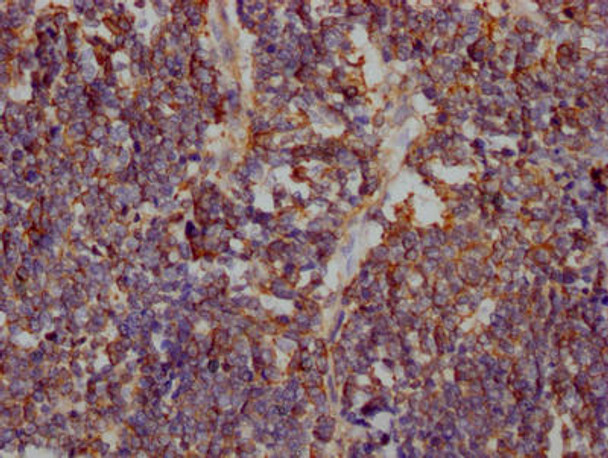Anti-SLC2A1 Antibody (RACO0223)
- SKU:
- RACO0223
- Product type:
- Recombinant Antibody
- Reactivity:
- Human
- Host Species:
- Human
- Isotype:
- IgG
- Application:
- ELISA
- Application:
- IHC
- Conjugation:
- Unconjugated
Frequently bought together:
Description
| 商品名: | SLC2A1 Antibody |
| Product SKU: | RACO0223 |
| サイズ: | 50ul |
| 宿主種: | Homo sapiens (Human) |
| 申し込み: | ELISA, IHC |
| 推奨される希釈: | IHC:1:50-1:200 |
| 反応性: | Human |
| 免疫原: | A synthesized peptide derived from human Glucose Transporter GLUT1 |
| 憲法: | Liquid |
| ストレージバッファ: | Rabbit IgG in phosphate buffered saline, pH 7.4, 150mM NaCl, 0.02% sodium azide and 50% glycerol. |
| 精製方法: | Affinity-chromatography |
| 抗体のクローン性: | Monoclonal |
| アイソタイプ: | Rabbit IgG |
| Conjugate: | Non-conjugated |
| バックグラウンド: | Facilitative glucose transporter. This isoform may be responsible for constitutive or basal glucose uptake. Has a very broad substrate specificity; can transport a wide range of aldoses including both pentoses and hexoses. |
| シノニム: | Solute carrier family 2, facilitated glucose transporter member 1 (Glucose transporter type 1, erythrocyte/brain) (GLUT-1) (HepG2 glucose transporter), SLC2A1, GLUT1 |
 | IHC image of RACO0223 diluted at 1:100 and staining in paraffin-embedded human lung cancer performed on a Leica BondTM system. After dewaxing and hydration, antigen retrieval was mediated by high pressure in a citrate buffer (pH 6.0). Section was blocked with 10% normal goat serum 30min at RT. Then primary antibody (1% BSA) was incubated at 4°C overnight. The primary is detected by a Goat anti-rabbit IgG polymer labeled by HRP and visualized using 0.05% DAB. |
 | IHC image of RACO0223 diluted at 1:100 and staining in paraffin-embedded human cervical cancer performed on a Leica BondTM system. After dewaxing and hydration, antigen retrieval was mediated by high pressure in a citrate buffer (pH 6.0). Section was blocked with 10% normal goat serum 30min at RT. Then primary antibody (1% BSA) was incubated at 4°C overnight. The primary is detected by a Goat anti-rabbit IgG polymer labeled by HRP and visualized using 0.05% DAB. |
| UniProt Protein Function: | GLUT1: an integral membrane protein that plays an important role in the glycolytic pathway by serving as a uniporter for glucose. One of 13 members of the human equilibrative glucose transport protein family. Transports a wide range of aldoses, including both pentoses and hexoses, and dehydroascorbic acid. Shown to transport water against an osmotic gradient. A receptor for the Human T-cell Leukemia virus (HTLV). Plays a role in the constitutive or basal uptake of glucose. Expressed at highest levels in proliferating cells of the early developing embryo, cells forming the blood tissue barriers, in human erythrocytes, astrocytes and in cardiac muscle. GLUT1 and GLUT3 are both essential for normal embryonic development. Is practically the only member of the GLUT family expressed on human red blood cells, where it comprises 10 - 20% of the integral membrane protein content. Several glycolytic proteins including the transporters GLUT1 and GLUT3, as well as multiple enzymes including HK2, PFKL, LDHA, ALDOA, ALDOC, PGK1, ENO1, PKM2, CA9 and PFKFB3 are induced in cancer cells by HIF-1 alpha. Polyps from Peutz-Jeghers patients exhibit up-regulated mTORC1 signaling, HIF-1alpha, and GLUT1 levels. Defects in GLUT1 are the cause of autosomal dominant GLUT1 deficiency syndrome, a blood-brain barrier glucose transport defect characterized by infantile seizures, delayed development, and acquired microcephaly. Defects also cause dystonia type 18, an exercise-induced paroxysmal dystonia/dyskinesia. Cytochalasin B binds to its inner surface, inhibiting its glucose transport activity with an IC50 of 0.44 uM. |
| UniProt Protein Details: | Protein type:Membrane protein, integral; Membrane protein, multi-pass; Transporter; Transporter, SLC family Chromosomal Location of Human Ortholog: 1p34.2 Cellular Component: cortical actin cytoskeleton; Golgi membrane; integral to plasma membrane; membrane; midbody; plasma membrane Molecular Function:D-glucose transmembrane transporter activity; dehydroascorbic acid transporter activity; glucose transmembrane transporter activity; identical protein binding; protein binding; protein self-association Biological Process: glucose transport; L-ascorbic acid metabolic process; lactose biosynthetic process; protein complex assembly; regulation of insulin secretion Disease: Stomatin-deficient Cryohydrocytosis With Neurologic Defects |
| NCBI Summary: | This gene encodes a major glucose transporter in the mammalian blood-brain barrier. The encoded protein is found primarily in the cell membrane and on the cell surface, where it can also function as a receptor for human T-cell leukemia virus (HTLV) I and II. Mutations in this gene have been found in a family with paroxysmal exertion-induced dyskinesia. [provided by RefSeq, Apr 2013] |
| UniProt Code: | P11166 |
| NCBI GenInfo Identifier: | 115502394 |
| NCBI Gene ID: | 6513 |
| NCBI Accession: | P11166.2 |
| UniProt Secondary Accession: | P11166,O75535, Q147X2, A8K9S6, B2R620, D3DPX0, |
| UniProt Related Accession: | P11166 |
| Molecular Weight: | 54,084 Da |
| NCBI Full Name: | Solute carrier family 2, facilitated glucose transporter member 1 |
| NCBI Synonym Full Names: | solute carrier family 2 member 1 |
| NCBI Official Symbol: | SLC2A1 |
| NCBI Official Synonym Symbols: | CSE; PED; DYT9; GLUT; DYT17; DYT18; EIG12; GLUT1; HTLVR; GLUT-1; SDCHCN; GLUT1DS |
| NCBI Protein Information: | solute carrier family 2, facilitated glucose transporter member 1 |
| UniProt Protein Name: | Solute carrier family 2, facilitated glucose transporter member 1 |
| UniProt Synonym Protein Names: | Glucose transporter type 1, erythrocyte/brain; GLUT-1; HepG2 glucose transporter |
| Protein Family: | Glucose transporter |
| UniProt Gene Name: | SLC2A1 |

